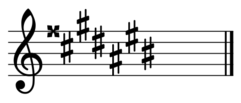G-sharp major
G-sharp major is a theoretical key based on the musical note G♯, consisting of the pitches G♯, A♯, B♯, C♯, D♯, E♯ and F##(![]()
 | |
| Relative key | E-sharp minor enharmonic: F minor |
|---|---|
| Parallel key | G-sharp minor |
| Dominant key | D-sharp major enharmonic: E-flat major |
| Subdominant | C-sharp major enharmonic: D-flat major |
| Enharmonic | A-flat major |
| Component pitches | |
| G♯, A♯, B♯, C♯, D♯, E♯, F | |
Its relative minor is E-sharp minor (usually replaced by F minor), its parallel minor is G-sharp minor, and its enharmonic equivalent is A-flat major.
The G-sharp major scale is:
Although G-sharp major is usually notated as the enharmonic key of A-flat major, because A-flat major has only four flats as opposed to G-sharp major's eight sharps (including the F![]()
The final pages of A World Requiem by John Foulds are written in G-sharp major with its correct key signature shown in the vocal score including the F![]()
![]()
References
- Thomas Busby (1840). "G-sharp major". A Dictionary of Three Thousand Musical Terms. revised by J. A. Hamilton. London: D'Almaine and Co. p. 55.
- http://www.musicsalesclassical.com/composer/work/14652